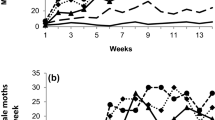Abstract
The tomato leafminer, Tuta absoluta (Lepidoptera: Gelechiidae), originates from South America and is now considered to be one of the most damaging invasive pests of tomatoes in the Mediterranean Basin countries of Europe and North Africa. The preventing pest mating control methods include: (1) the use of synthetic pheromones for male attraction and annihilation inside insecticide-containing traps; (2) mating disruption by saturating the atmosphere with sex pheromones which alter the ability of males to locate females; and (3) massive applications of sterile males to alter the overall reproductive success of the pest population. However, all these methods achieve only a poor success rate in controlling T. absoluta populations under greenhouse conditions. Sex pheromone management and sterile insect techniques are both based on an important biological trait: the insect must breed through sexual reproduction. Here, we report for the first time laboratory evidence of deuterotokous parthenogenesis, an asexual reproduction where both males and females are produced from unfertilized eggs. We discuss the consequences for T. absoluta control strategies.
Similar content being viewed by others
References
Ball SL (2001) Tychoparthenogenesis and mixed mating in natural populations of the mayfly Stenonema femoratum. Heredity 87(3):373–380
Beukeboom LW (2012) Microbial manipulation of host sex determination: endosymbiotic bacteria can directly manipulate their host’s sex determination towards the production of female offspring. Bioessays 34(6):484–488
Carde RT (2007) Using pheromones to disrupt mating of moth pests. In: Kogan M, Jepson P (eds) Perspectives in ecological theory and integrated pest management. Cambridge University Press, Cambridge, pp 122–169
Carde RT, Minks AK (1995) Control of moth pests by mating disruption: successes and constraints. Ann Rev Entomol 40:559–585
Chevasco V, Elzinga JA, Viinikainen SM, Mappes J, Galarza JA (2012) Unexpected genetic variability in the parthenogenetic bag worm moth Dahlica fennicella (Lepidoptera: Psychidae) revealed by novel microsatellite markers. Conserv Genet Resour 4(1):159–162
Cocco A, Deliperi S, Delrio G (2012) Control of Tuta absoluta (Meyrick) (Lepidoptera: Gelechiidae) in greenhouse tomato crops using the mating disruption technique. J App. Entomol (in press)
Coelho MCF, França FH (1987) Biologia e quetotaxia da larva e descrição da pupa e adulto da traça do tomateiro. Pesq Agro Brasil 22:129–135
Cunningham RT (1989) Male annihilation. In: Robinson AS, Cooper G (eds) Fruit flies: their biology, natural enemies and control. World crop pest. Elsevier, Amsterdam, pp 345–351
de Oliveira CM, de Andrade Júnior VC, Maluf WR, Neiva IP, Maciel GM (2012) Resistance of tomato strains to the moth Tuta absoluta imparted by allelochemicals and trichome density. Ciênc Agrotechnol 36(1):45–52
Desneux N, Wajnberg E, Wyckhuys KAG, Burgio G, Arpaia S, Narváez-Vasquez CA, González-Cabrera J, Ruescas DC, Tabone E, Frandon J, Pizzol J, Poncet C, Cabello T, Urbaneja A (2010) Biological invasion of European tomato crops by Tuta absoluta: ecology, geographic expansion and prospects for biological control. J Pest Sci 83(3):197–215
Desneux N, Luna MG, Guillemaud T, Urbaneja A (2011) The invasive South American tomato pinworm, Tuta absoluta, continues to spread in Afro-Eurasia and beyond: the new threat to tomato world production. J Pest Sci 84(4):403–408
Grassé PP (1949) La Parthénogenèse. Masson, Paris
Hassan N, Al-Zaidi S (2010) Tuta absoluta—pheromone mediated management strategy. Int Pest Control 52(3):158–160
Klassen W, Curtis C (2005) History of the sterile insect technique. In: Dyck V, Hendrichs J, Robinson AS (eds) Sterile insect technique. Springer, Dordrecht, pp 3–36
Lynch M (1984) Destabilizing hybridization, general-purpose genotypes and geographic parthenogenesis. Q Rev Biol 59(3):257–290
Menken SBJ, Wiebosch-Steeman M (1988) Clonal diversity, population structure, and dispersal in the parthenogenetic moth Ectoedemia argyropeza. Entomol Exp Appl 49(1–2):141–152
Michereff Filho M, Vilela EF, Jham GN, Attygalle A, Svatoš A, Meinwald J (2000) Initial studies of mating disruption of the tomato moth, Tuta absoluta (Lepidoptera: Gelechiidae) using synthetic sex pheromone. J Braz Chem Soc 11(6):621–628
Mitter C, Futuyma D (1977) Parthenogenesis in the fall cankerworm, Alsophila pometaria (Lepidoptera, Geometridae). Entomol Exp Appl 21(2):192–198
Mittwoch U (1978) Parthenogenesis. J Med Gen 15(3):165–181
Morrison N, Walker A, Baxter I, Harveay-Samuel T, Hdidi A, Alphey L (2011) Investigating the potential of genetic control as part of an IPM approach for Tuta absoluta. In: International Symposium on Management of Tuta absoluta, Agadir, Marocco
Mozuraitis R, Buda V, Liblikas I, Unelius CR, Borg-Karlson AK (2002) Parthenogenesis, calling behavior, and insect-released volatiles of leafminer moth Phyllonorycter emberizaepenella. J Chem Ecol 28(6):1191–1208
Portier P (1949) La biologie des Lépidoptères. Lechevalier P, Paris
Škaljac M, Kostanjšek R, Žanić K (2012) The presence of Wolbachia in Tuta absoluta (Lepidoptera: Gelechiidae) populations from coastal Croatia and Montenegro. Afr Entomol 20(1):191–194
Suomalainen E (1962) Significance of parthenogenesis in the evolution of insects. Ann Entomol 7:349–366
Trehan KN, Bagal SR (1944) Life-history and bionomics of potato tuber moth (Phthorimaea operculella Zell., Lepidoptera: Gelechiidae). Proc Indian Acad Sci Sect B 19(5):176–187
Vacas S, Alfaro C, Primo J, Navarro-Llopis V (2011) Studies on the development of a mating disruption system to control the tomato leafminer, Tuta absoluta Povolny (Lepidoptera: Gelechiidae). Pest Manag Sci 67(11):1473–1480
Acknowledgments
This research was funded by the Service Public de Wallonie (SPW–DGO3, Project D31-1263).
Author information
Authors and Affiliations
Corresponding author
Additional information
Communicated by N. Desneux
Rights and permissions
About this article
Cite this article
Caparros Megido, R., Haubruge, E. & Verheggen, F.J. First evidence of deuterotokous parthenogenesis in the tomato leafminer, Tuta absoluta (Meyrick) (Lepidoptera: Gelechiidae). J Pest Sci 85, 409–412 (2012). https://doi.org/10.1007/s10340-012-0458-6
Received:
Accepted:
Published:
Issue Date:
DOI: https://doi.org/10.1007/s10340-012-0458-6




